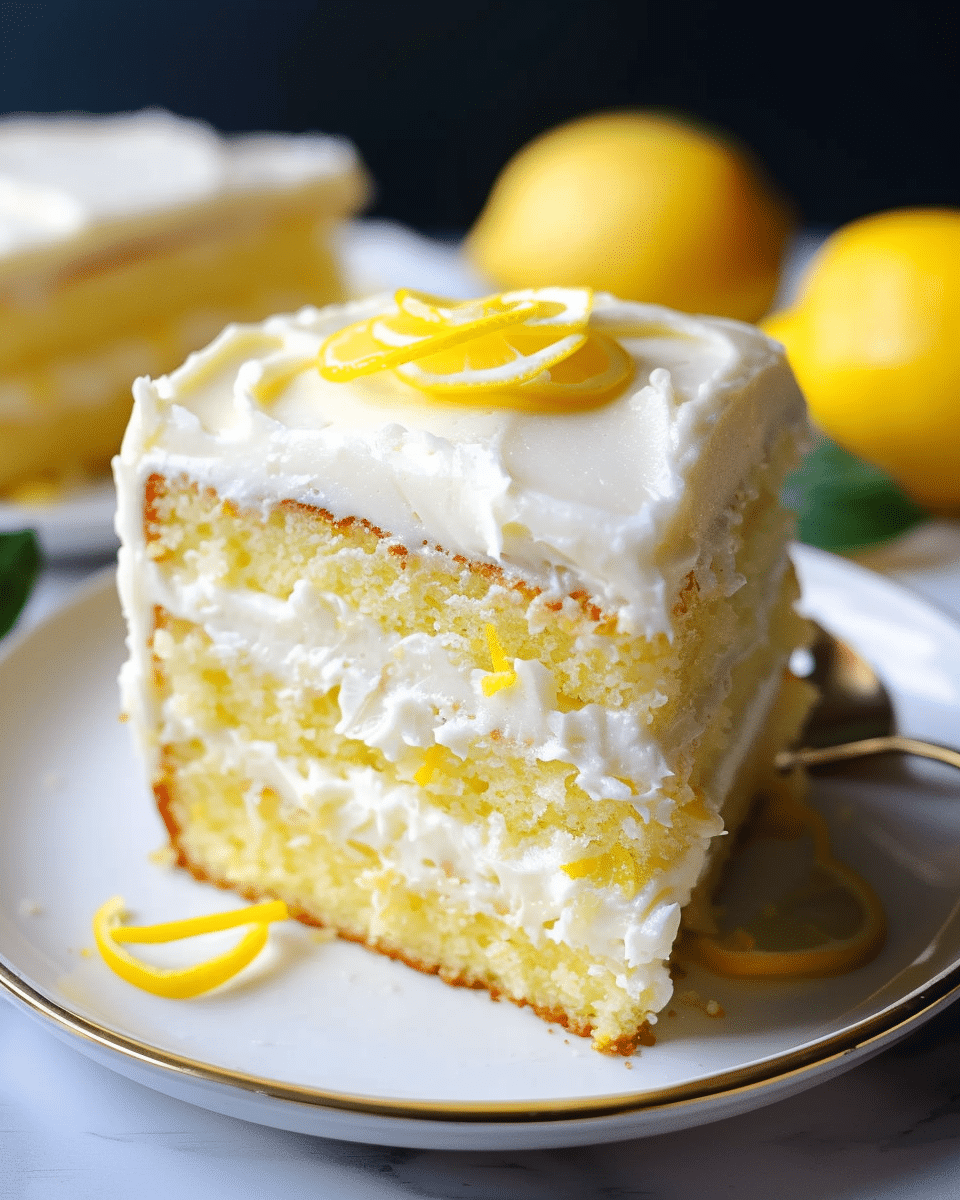Lemon Velvet Cake with Lemon Cream Cheese Frosting offers a bright, tender crumb and tangy sweetness, perfect for any celebration. This recipe guides you through creating layers of citrus flavor with a smooth, luxurious finish. You will learn the secrets to a perfectly moist texture and the best way to make the vibrant, tangy cream cheese frosting. Get ready to bake a showstopping dessert that tastes like pure sunshine.
Key Takeaways
- Achieve the signature “velvet” texture by using both all-purpose and cake flours.
- The combination of lemon extract and fresh zest boosts the citrus flavor significantly.
- Buttermilk and vinegar react with baking soda for a perfectly moist and tender crumb.
- Ensure your cake layers are completely cool before applying the cream cheese frosting.

Lemon Velvet Cake gets its signature tender texture from a blend of cake flour and buttermilk, along with a bit of vinegar. For intense flavor, you should use both lemon extract and fresh lemon zest. The cake is baked at a low temperature ($325^{\circ}\text{F}$) to keep it moist, and it’s essential to not overmix the batter, guaranteeing a light, airy result every time.
Why Lemon Velvet Cake is Your Next Favorite Dessert
Lemon Velvet Cake is truly the ideal dessert for any springtime gathering or summer celebration. This particular cake is renowned for its luxuriously soft and tender texture, which is where the “velvet” name comes from. It offers a sophisticated flavor profile that balances bright lemon tanginess with just the right amount of sweetness, making it irresistible.
You will appreciate how the delicate citrus flavor permeates every single layer of the cake. The addition of tangy buttermilk and vinegar ensures that the crumb stays incredibly moist and light. You’re not just baking a cake; you’re creating an experience of pure, sunny flavor that is light years beyond a simple lemon sheet cake.
The Secret to a Tender Velvet Crumb
The secret to achieving that characteristic tender texture lies in the careful combination of ingredients. This recipe cleverly uses both all-purpose flour and cake flour, creating a structure that is strong yet delicate. Cake flour, with its lower protein content, is key to the light, velvety mouthfeel you want to achieve.
Also important is the role of fats, as you are mixing vegetable oil and butter-flavored shortening into your batter. This blend helps to keep the cake moist far longer than if you were using butter alone. You should also ensure that your wet ingredients are properly beaten until they are light and fluffy before you add the dry components.
Blending the Flours for Optimal Texture
Using a mixture of flours ensures the perfect balance of rise and tenderness in your final cake. The all-purpose flour provides the necessary structure to support the cake’s height and weight. Meanwhile, the cake flour works wonders to soften the final texture, giving it the true velvet crumb.
You must whisk the flours together with the leavening agents like baking soda and baking powder very thoroughly. This step prevents pockets of unmixed ingredients and guarantees a uniform rise. The light blend of flours is foundational to the unique texture of this Lemon Velvet Cake.
Boosting the Bright Lemon Flavor
The intensity of the lemon flavor is what sets this dessert apart from other citrus cakes. You’ll be using several ingredients to layer the flavor, ensuring a bold, natural, and vibrant taste. The fresh lemon zest provides aromatic oils, while both fresh juice and lemon extract deliver a deep, consistent tang throughout.
Make sure you don’t skimp on the fresh lemon zest, as it holds the most concentrated lemon oil. Adding a tablespoon of lemon extract, along with the vanilla, further enhances the overall flavor profile. This triple-lemon approach creates a bright, refreshing taste that truly shines through the sweetness of the cake batter.
Using Zest and Extract for Depth
Zest and extract play two very different but equally critical roles in flavor development. The zest contributes a fresh, lively, and slightly floral note to the cake batter. You should rub the sugar and zest together slightly to release its essential oils before mixing.
The lemon extract, on the other hand, provides a robust, consistent lemon background flavor that doesn’t bake out as easily. This dual approach ensures that every single bite delivers a punch of authentic citrus flavor. You can read more about the difference between extracts and zest on Wikipedia’s lemon extract page.
The Essential Role of Buttermilk and Vinegar
Buttermilk and vinegar are not just simple liquids in this Lemon Velvet Cake recipe; they are active ingredients that create chemical reactions. The acidity in both components reacts with the baking soda and baking powder. This reaction is what helps the cake rise beautifully and contributes to the super moist texture.
The buttermilk adds a subtle richness and tangy depth that complements the bright lemon perfectly. Furthermore, the acid in the buttermilk helps to tenderize the gluten in the flour. This action prevents the cake from becoming tough or chewy, instead yielding a soft, velvety crumb that lives up to its name.
Tips for Baking Perfect Cake Layers
Baking two uniform cake layers is crucial for a stunning final presentation. You should always ensure the oven is fully preheated to the specified temperature before you put the batter in. Using an oven thermometer can confirm accuracy, as oven temperatures often fluctuate.
You’ll want to divide the batter as evenly as possible between your prepared pans; using a kitchen scale is the best way to guarantee this. Remember the advice: check the cakes a few minutes early. The centers should be just set but still slightly jiggly when you remove them from the oven, preventing an over-baked, dry cake. For more dinner ideas, you can check out our Easy Honey Garlic Chicken recipe.
Preventing an Overmixed Batter
Overmixing the batter is one of the most common mistakes that can lead to a dense, dry cake. Once you introduce the wet and dry ingredients, you only need to mix until they are just combined. You should stop mixing as soon as you no longer see streaks of dry flour.
Mixing too vigorously or for too long develops the gluten in the flour excessively, resulting in a tough cake. A gentle hand and minimal stirring are your best friends in this step. You want a batter that is smooth, but you shouldn’t worry if there are a few very tiny lumps left.
Making the Luscious Lemon Cream Cheese Frosting
The Lemon Cream Cheese Frosting is the crowning glory of the Lemon Velvet Cake, providing a beautiful contrast. You must start by ensuring both the cream cheese and unsalted butter are fully softened before you begin beating them. This step is non-negotiable for achieving a smooth, lump-free frosting.
You should beat the butter and cream cheese together until the mixture is truly light and fluffy, incorporating air for volume. Then, gradually add the powdered sugar, mixing on low speed to prevent a cloud of sugar from enveloping your kitchen. Add the extracts and fresh zest for that beautiful, vibrant lemon flavor.
Achieving the Perfect Frosting Consistency
The consistency of your Lemon Cream Cheese Frosting is vital for easy spreading and a stable final cake. If the frosting seems too thick, you can add a tiny splash of lemon juice—about one teaspoon at a time—until it reaches the right spreadable consistency. If it’s too thin, simply add a bit more powdered sugar.
Remember that cream cheese frosting is softer than traditional buttercream, especially in a warm kitchen. If you find your frosting is becoming too soft to work with, a quick chill in the refrigerator for about 15 minutes will firm it up. The perfect consistency should be creamy but hold its shape well when piped.
Cooling and Assembling Your Lemon Velvet Cake
Proper cooling is perhaps the most critical, often overlooked, step in successful cake assembly. You must allow the baked layers to cool in the pans for about ten minutes before you attempt to invert them onto a wire rack. This period allows the delicate structure of the cake to set fully.
Once on the wire rack, the cake layers must cool completely before you even think about applying the frosting. Trying to frost a warm cake is a recipe for disaster; the frosting will immediately melt and slide off. Complete cooling might take up to two hours, so plan your baking day accordingly for the best results, perhaps while you are waiting, check out our Main Course category for dinner inspiration.
How to Garnish for a Stunning Presentation
A beautifully assembled cake deserves a stunning final touch for a professional look. The simplest and most elegant garnish for this Lemon Velvet Cake is thinly sliced fresh lemon. You can arrange the slices in a spiral pattern or simply around the bottom border of the cake.
Alternatively, you could sprinkle a light dusting of powdered sugar over the top layer of frosting. For a textural element, consider adding a sprinkle of crystallized lemon peel or chopped pistachios around the bottom edge. For visual inspiration, follow us on Pinterest and Instagram.
Storage and Preparation Notes for Lemon Velvet Cake
Knowing how to store your Lemon Velvet Cake ensures that you can enjoy its fresh flavor for days after baking. Because the cake contains cream cheese frosting, it must be stored in the refrigerator. An airtight container will prevent the cake from absorbing any unwanted odors and drying out.
When storing, you may also make the frosting ahead of time; it can be refrigerated in an airtight container for up to three days. Just remember that you will need to let it warm up slightly and beat it again before using it to restore its smooth consistency. For another amazing dessert, check out our Peanut Butter Brownie Swirl Cookies.
Making the Cake Layers Ahead of Time
You can certainly prepare the Lemon Velvet Cake layers ahead of time to make your baking day easier. Once the layers are fully cooled, you should wrap them tightly in plastic wrap, then place them inside a large freezer bag. They can be kept in the freezer for up to three months.
When you are ready to assemble the cake, simply thaw the wrapped layers in the refrigerator overnight. This preparation method is an excellent way to reduce stress before a big event. It allows you to focus solely on making the perfect frosting on the day of the party. The ingredients for the cake, such as baking soda, are discussed further on Wikipedia’s sodium bicarbonate page.
Common Questions About Lemon Velvet Cake
Many bakers have questions about achieving the best results with specialty cakes like this one. A frequent question is whether you can substitute regular milk for the buttermilk. While you can, it’s not recommended, as you will lose the signature tenderness and tang that the buttermilk provides.
Another common query relates to the bright yellow color. The recipe includes food coloring as an optional addition for a more vibrant hue. If you prefer a natural look, you can omit the coloring, and the cake will still have a lovely, pale yellow shade from the lemon zest and egg yolks.
Why is My Lemon Velvet Cake Not Moist?
If your Lemon Velvet Cake came out dry, it is most likely due to one of two reasons: overmixing the batter or overbaking the layers. Overmixing develops the gluten, making the cake tough and dry. Remember, mix only until the dry streaks disappear and no further.
Overbaking is also a major culprit; keep a close eye on the clock and the texture. You should remove the cakes when they are just set in the center. An extra five minutes in the oven can be the difference between a perfectly moist velvet cake and a disappointing dry one, so set a timer.
Can I Make Lemon Velvet Cake Gluten-Free?
Yes, you can adapt this Lemon Velvet Cake recipe to be gluten-free, although some minor adjustments may be necessary. You should substitute the all-purpose and cake flours with a high-quality 1:1 gluten-free baking blend that contains xanthan gum. You might need to add a touch more liquid.
The texture may be slightly different, but the core lemon flavor profile and velvet concept will remain. Many gluten-free flour blends work very well in cake recipes, yielding a surprisingly tender and delicious result. Experimentation is often key to finding the perfect blend that works for your preferred taste.
Serving Suggestions for Lemon Velvet Cake
This dessert is elegant enough to serve on its own, but a few simple additions can elevate the presentation further. Serve each slice with a small dollop of fresh, lightly sweetened whipped cream. This provides an additional layer of delicate creaminess that contrasts beautifully with the tangy frosting.
For a refreshing pairing, consider serving the cake with a side of fresh seasonal berries, such as blueberries or raspberries. The tartness of the berries complements the lemon wonderfully, creating a bright and balanced finish. A simple cup of black tea or a bright iced beverage pairs perfectly.
Lemon Velvet Cake is a sophisticated and rewarding dessert that is perfect for celebrating any special occasion. The luxurious texture and vibrant, fresh lemon flavor make this cake truly unforgettable. You’ve now mastered the techniques needed to bake tender layers and prepare the luscious lemon cream cheese frosting. Don’t be afraid to try this recipe for your next event.
Lemon Velvet Cake will impress every guest with its beautiful look and incredible taste. It’s the ideal bake when you want a showstopper that feels both classic and new at the same time. You can now confidently add this stunning and moist cake to your regular baking rotation for years to come.
Print
Lemon Velvet Cake with Lemon Cream Cheese Frosting
- Total Time: 1 hr 10 mins
Description
This sunny lemon velvet cake is pure citrus bliss! The tender cake layers and luscious lemon cream cheese frosting make for the ultimate taste of springtime.
Ingredients
For the Cake:
- 1 1/2 cups all-purpose flour
- 1 cup cake flour
- 1 tsp baking soda
- 1 tsp baking powder
- 1 tsp salt
- 1 3/4 cups granulated sugar
- 3/4 cup vegetable oil
- 1/4 cup butter-flavored shortening
- 2 large eggs
- 1–2 tsp vanilla extract
- 1 tbsp lemon extract
- 1 heaping tsp lemon zest
- 1 cup buttermilk
- 1/2 tsp white vinegar
- 1/3 cup hot lemon water (2 tbsp lemon juice mixed with 1/3 cup hot water)
- 4–6 drops yellow food coloring (optional)
For the Lemon Cream Cheese Frosting:
- 16 oz cream cheese (softened)
- 8 tbsp unsalted butter (softened)
- 1 1/2 tsp vanilla extract
- 1 1/2 tsp lemon extract
- 1 1/2 heaping tsp lemon zest
- 4–5 cups powdered sugar
- 1–2 tsp lemon juice (if needed)
- 4–5 drops yellow food coloring (optional)
Instructions
- Preheat oven to $325^{circ} ext{F}$. Grease and flour two 9-inch cake pans.
- In a bowl, whisk together the flours, baking soda, baking powder and salt.
- In another bowl, beat the sugar, oil, shortening, eggs, vanilla, lemon extract and zest until light and fluffy.
- Alternate mixing the dry ingredients and buttermilk into the wet ingredients until just combined.
- Mix the vinegar and hot lemon water together, then stir into the batter along with food coloring if using.
- Divide batter evenly between pans. Bake 25-30 mins until centers are just set.
- Let cakes cool in pans 10 mins, then transfer to a wire rack to cool completely.
- For frosting, beat cream cheese and butter until fluffy. Mix in extracts, zest and powdered sugar until smooth.
- Frost cooled cake layers with lemon cream cheese frosting. Garnish with lemon slices if desired.
Notes
For ultimate lemon flavor, use fresh lemon juice and zest.
Don’t overmix batter once the wet and dry ingredients are combined.
Check cakes a few minutes early and remove when centers are just set but still slightly jiggly.
Let cakes cool completely before frosting.
Frosting can be made ahead and refrigerated until ready to use.
- Prep Time: 30 mins
- Cook Time: 40 mins
Nutrition
- Serving Size: 12
Keywords: cake, dessert, lemon, velvet, cream cheese

